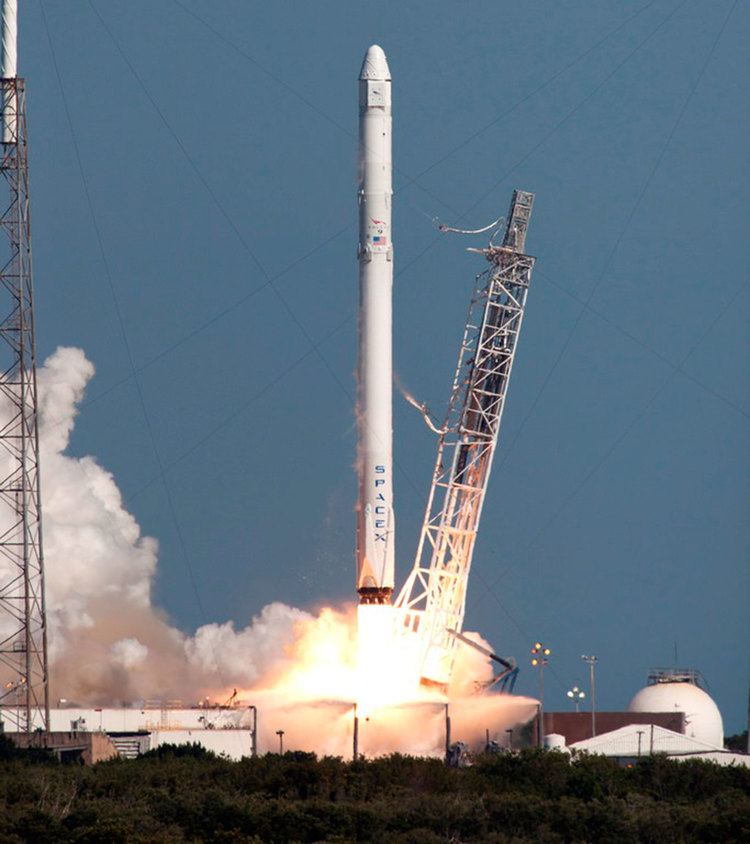Mission type ISS resupply COSPAR ID 2016-024A Spacecraft type Dragon | SATCAT no. 41452 Dates 8 Apr 2016 – 11 May 2016 | |
 | ||
Mission duration 32 days, 21 hours, 48 minutes | ||
Spacex crs 8 successfully landing on drone ship
SpaceX CRS-8, also known as SpX-8, was a cargo resupply mission to the International Space Station (ISS) which was launched on April 8, 2016, at 20:43 UTC. It was the 23rd flight of a Falcon 9 rocket, the tenth flight of a Dragon cargo spacecraft and the eighth operational mission contracted to SpaceX by NASA under the Commercial Resupply Services program. The capsule carried over 3,100 kilograms (6,800 lb) of cargo to the ISS including the Bigelow Expandable Activity Module (BEAM), a prototype inflatable space habitat delivered in the vehicle's trunk, which will be attached to the station for two years of in-orbit viability tests.
Contents
- Spacex crs 8 successfully landing on drone ship
- Launch schedule history
- Primary payload
- First stage landing
- Port arrival
- First stage reflight
- References

After boosting the payload on its orbital trajectory, the rocket's first stage re-entered the denser layers of the atmosphere and landed vertically on the ocean landing platform Of Course I Still Love You nine minutes after liftoff, achieving a long-sought-after milestone in SpaceX reusable launch system development program. This marks the first time a reusable rocket was able to complete its mission and achieve a soft landing on an ocean-based platform.

This flight's first stage is slated to be the first one reflown by SpaceX, and is intended to be reused in the launch of the SES-10 satellite in early 2017.

Launch schedule history

The launch was initially scheduled by NASA to occur no earlier than September 2, 2015. The launch date went under review pending the outcome of the analysis of the failure of the Falcon 9 launch vehicle in SpaceX CRS-7, a June 2015 flight. The return-to-flight (RTF) project included additional improvements.
With additional manifest changes announced by SpaceX in mid-October, CRS-8 was scheduled to be the third launch of the upgraded Falcon 9 full thrust rocket. By March 2016, the launch date was set to April 8, 2016, with a backup launch window the next day.
The spacecraft was finally launched on schedule, at 20:43 UTC on April 8, 2016. The rocket first stage separated around 2 minutes 40 seconds after liftoff, and the second stage separated around ten minutes 30 seconds after liftoff.
Primary payload
NASA has contracted for the CRS-8 mission from SpaceX and therefore determines the orbital parameters for the primary payload – the Dragon space capsule.
The mission delivered 3,136 kilograms (6,914 lb) of supplies, experiments, and hardware to the ISS. These include the station's first expandable module, called the Bigelow Expandable Activity Module (BEAM), which is expected to remain on the station for at least two years of observation and testing. Also delivered in the Dragon were sixteen Flock 2d 3U CubeSats for the Earth-observing Flock constellation, built and operated by Planet Labs, which will be deployed by the NanoRacks CubeSat Deployer.
First stage landing
After placing the CRS-8 cargo on its way to the International Space Station, the first stage of the Falcon 9 rocket conducted an experimental boostback and re-entry maneuver over the Atlantic Ocean. Nine minutes after liftoff, at 20:52:10 UTC, the booster landed vertically on the autonomous spaceport drone ship Of Course I Still Love You, 300 kilometers (190 mi) from the Florida coastline, achieving a long-sought-after milestone for the SpaceX reusable launch system development program. The video of the landing of the booster shows one of the legs outside of the bull's eye's outer circle.
This was the second successful landing achieved by a SpaceX orbital launch vehicle and the first vertical landing by any organization on a floating platform. SpaceX first landed a Falcon 9 on solid ground at Cape Canaveral with flight 20 on December 22, 2015.
Port arrival
The drone ship carried the stage to Port Canaveral, Florida, arriving on April 12, 2016 (UTC), where it was offloaded. SpaceX plans to keep this first stage in Cape Canaveral and conduct a series of test fires to ensure that the vehicle is ready for a future operational mission. According to SpaceX CEO Elon Musk, the rocket will likely be test-fired at Kennedy Space Center Launch Complex 39. Musk noted that assuming the test fires went well, the stage would likely be reflown for a mission in June 2016.
First stage reflight
As of December 2016, SpaceX has not attempted a reflight of one of their recovered booster rockets. The first stage of Falcon 9 Flight 23—which transported this CRS-8 Dragon capsule on an orbital trajectory in April 2016—is scheduled to be reflown first, in February 2017. Additional tests will be conducted before SpaceX determines the stage's final suitability for reuse on a subsequent launch. On January 31, 2017 SpaceX posted a photo of a static fire test of this stage in Texas to prepare for launch in March with SES 10.
As part of a multi-month multi-vehicle test process to refly Falcon 9 boosters, another first stage of a different launch vehicle — Falcon 9 Flight 24 — was designated a "reference vehicle" for further testing, because it encountered "extreme temperatures during its reentry into Earth atmosphere" in May 2016 from a more energetic GTO trajectory. The Flight 24 first stage has undergone a series of tests, including a 150-second full-duration engine firing which was successfully completed on 28 July 2016.
